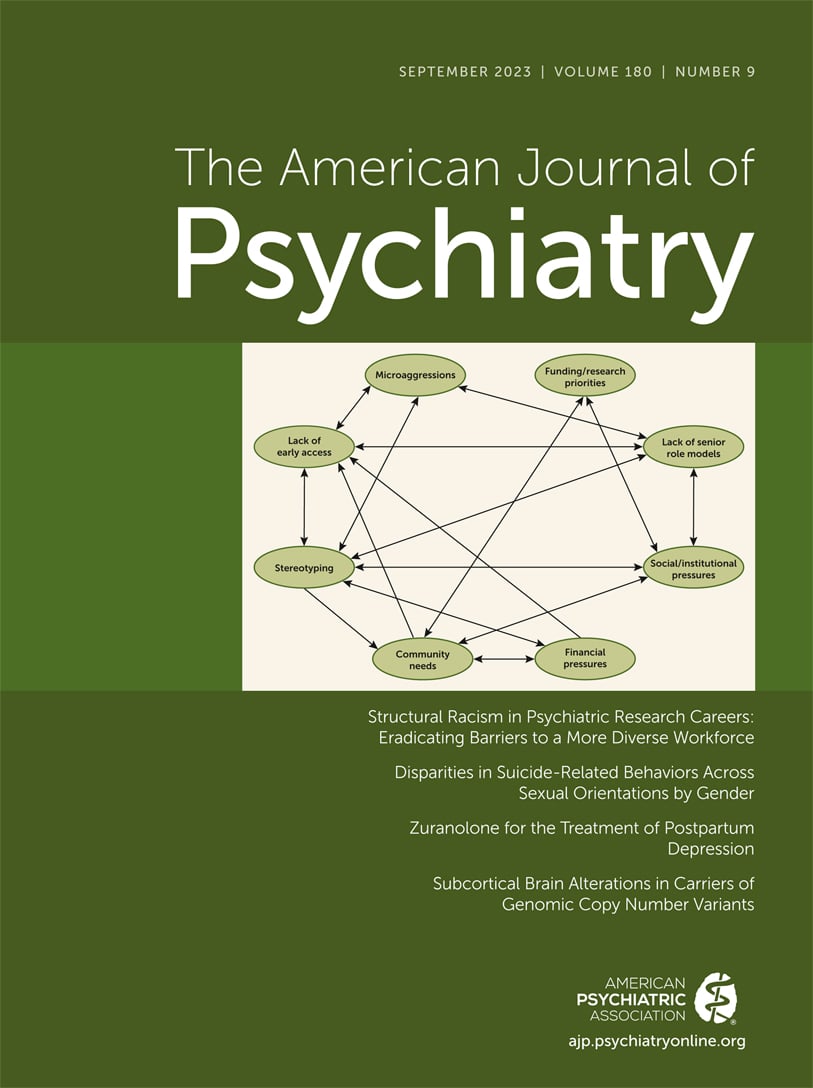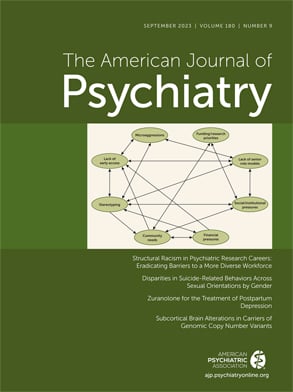Few articles appearing in medical journals provide more important information than randomized controlled trials (RCTs). Readers are in for a rare treat by encountering two such papers in the September issue of the
Journal dealing with a common theme. Both RCTs examine zuranolone, which targets γ-aminobutyric acid (GABA) signaling as an allosteric modulator of GABA
A receptors. In one article, Deligiannidis et al. (
1) test efficacy for postpartum depression, and in the other, Clayton et al. (
2) test efficacy in major depressive disorder (MDD). Across the two reports, readers might appreciate three key messages. The first speaks to clinicians looking for novel treatments that might provide help in the near term for their patients with mood disorders. A second message concerns the potential for therapeutic discovery in the longer term through studies on mechanism-based treatments. The final key message relates to the possibility of leveraging biological measures to parse heterogeneity in MDD.
Soon-to-Appear New Treatment?
Approval from the U.S. Food and Drug Administration (FDA) for new medications typically rests heavily on the results from phase 3 trials. Such approval usually requires at least two RCTs demonstrating effects of a medication, each in more than 100 patients, as is the case with the studies reported in this issue. In fact, with support from Sage Therapeutics and Biogen, the two trials reported here likely influenced the FDA decision earlier this year to accept an application for zuranolone as a treatment for postpartum depression and MDD. While this medication is not currently available in the United States, plans to make it available could move closer to reality before the publication of this editorial. The FDA set a deadline of early August 2023 for making additional decisions concerning zuranolone availability. Thus, clinicians might attend both to possible announcements from the FDA and to the contents of this month’s issue concerning zuranolone.
If zuranolone does receive FDA approval, results from Deligiannidis et al. (
1) may prove influential. This trial randomized 196 patients with postpartum depression to either 50 mg/day of zuranolone or placebo treatment for 14 days. To be included in the study, patients were required to manifest high levels of depressive symptoms after having developed an MDD episode either during the third trimester of pregnancy or within 4 weeks after their child’s birth. In terms of efficacy, not only were significantly greater effects seen on the primary outcome measure for medication than for placebo, but these effects arose 3 days into treatment. Such effects could provide rapid relief for suffering patients, and they result from a novel therapeutic mechanism.
Observing clinical effects at 3 days is unusual; most antidepressants do not yield clinical effects before 2 weeks. Of note, early clinical observations had suggested that benzodiazepines, which affect GABA through a different mechanism than zuranolone, also might produce rapid therapeutic responses in depression, by reducing comorbid anxiety and promoting sleep. However, no set of RCTs provided sufficiently clear evidence of efficacy to support an FDA indication for benzodiazepine treatment of depression. Thus, pharmacological differences between benzodiazepines and zuranolone could generate unique clinical effects. Finally, in treating postpartum depression, effects of zuranolone emerged across many secondary measures, and the treatment was generally well tolerated. As such, findings from this one RCT provide relatively clear results, a rare event in research on new antidepressants.
Mechanism-Based Treatments
The scientific path leading to trials of zuranolone involves two sets of findings from basic science research on mechanisms hypothesized to cause or sustain mood disorders. Such a mechanism-based path to therapeutic discovery differs from the path followed for most available antidepressants, which rests on serendipitous clinical discoveries. Details from basic science research can help clinicians understand pharmacodynamic features of therapeutic responses and can help researchers find clues that enable the discovery of other novel treatments.
One set of basic science findings implicated GABA signaling in mood disorders. Research in this area stimulated attempts to develop neuroactive steroids as therapeutic agents. More than a decade ago, a wealth of research had firmly implicated neuroactive steroids in excitatory-inhibitory neuronal balance and endogenous modulation of the stress response (
3). This extended an even larger series of investigations relating the neurobiology of the stress response to hedonic regulation. Together, studies linking neuroactive steroids, stress responsivity, and hedonic regulation motivated scientists searching for new antidepressants. This led to druggable targets within GABA
A receptors engaged by medications like zuranolone.
The second set of basic science findings involved observations on allopregnanolone, a hormone that is an endogenous modulator of GABA
A receptors. Marked fluctuations occur in this hormone during the peripartum period, and translational research implicated these fluctuations in the abrupt onset of mood symptoms (
4). These observations led to studies of brexanolone, which received FDA approval in 2019 as a treatment for moderate to severe postpartum depression (
5). The intravenous route of administration created some clinical burden in the use of this agent. Zuranolone may broaden clinical applications of the basic science research behind brexanolone by providing a once-daily oral agent, presumed to act through the same mechanism. The rapid nature of response for the two medications, coupled with comparability of their pharmacodynamic effects, strongly suggests a shared mechanism.
At one level, these findings are important because they validate efforts to leverage basic science to improve the lives of patients. At another level, the findings outline a pathway that might guide research on many problems, where basic science identifies mechanisms to be targeted for therapeutic gain. The success of this research should serve as a motivator for translational neuroscientists seeking new treatments.
Heterogeneous Nature of Mood Disorders
Comparing efficacy across studies provides clues about relations between therapeutics and clinical heterogeneity. Patients in the RCT reported by Deligiannidis et al. manifested relatively homogeneous depressive features, having developed a new MDD episode in the peripartum period, with a score of at least 26 on the Hamilton Depression Rating Scale (HAM-D). This contrasts with the patients reported by Clayton et al., who manifested MDD in more heterogeneous clinical contexts, with a HAM-D score of at least 24. Thus, the inclusion criteria encompass a more homogeneous group in the Deligiannidis et al. study than in the Clayton et al. study. Moreover, clinical effects in the former also appeared somewhat stronger than in the latter. Whereas Deligiannidis et al. found effects on most outcome measures, Clayton et al. found significant results on the HAM-D, the primary outcome measure, but not on the Clinical Global Impressions severity scale, a key secondary outcome measure.
Beyond the two new reports in this issue, two additional phase 3 studies of zuranolone recently appeared in the literature. This yields two new studies of postpartum depression and two new studies of MDD. Patterns across the four studies recall within-study inconsistencies in the MDD report in this issue of the
Journal. The other phase 3 study for MDD failed to meet criteria for efficacy on the primary endpoint (
6). Of note, dosage could be relevant, as the negative study in MDD used dosages of no more than 30 mg/day of zuranolone, unlike the 50 mg/day dosage in the Deligiannidis et al. and Clayton et al. studies. However, unlike in MDD, the other phase 3 study in postpartum depression did support efficacy despite using only 30 mg/day dosages (
7), findings consistent with the RCT of postpartum depression reported in this issue. Hence, across four RCTs, response to zuranolone appears more consistent in postpartum depression than in MDD.
Strong clinical response to zuranolone in postpartum depression may provide clues about mood disorder subtypes. One subtype might manifest a unique profile on clinical presentation, pathophysiology markers related to allopregnanolone, and therapeutic response to positive allosteric modulation of GABA
A receptors. Confirmation of this possibility would require new data linking changes on clinical and pathophysiology indices induced by GABA
A modulation. For example, if changes in depression with zuranolone consistently relate to changes in allopregnanolone or similar chemicals, a unique patient subtype could be identified involving pathophysiology sensitive to GABA
A allosteric modulators (
4).
This example related to allopregnanolone could fit within a broader research agenda designed to parse heterogeneity in mood disorders. By leveraging diverse biomarkers related to diverse types of mood disorder treatment response, this broader agenda could identify other meaningful patient subgroups. For example, other research on MDD currently parses subtypes of patients based on patterns of resting-state functional MRI connectivity (rsfMRI). This work might usefully link rsfMRI patterns to therapeutic brain stimulation responses (
8). Moreover, similar to such studies of brain stimulation, yet other work uses biomarkers to identify patients uniquely responsive to psychotherapy (
9). Thus, the Deligiannidis et al. and Clayton et al. studies could portend attempts to parse clinical heterogeneity across broad groups of patients. Subtypes might be defined using biological markers linked to treatment responses.
Conclusions
RCTs provide key insights for clinicians, and new data from RCTs suggest that zuranolone could emerge as a novel therapy for mood disorders. Continued accrual of promising data in related areas might support a broader shift in therapeutic discovery. This shift could emphasize a parsing of clinical heterogeneity through biomarkers linked to therapeutic response.

